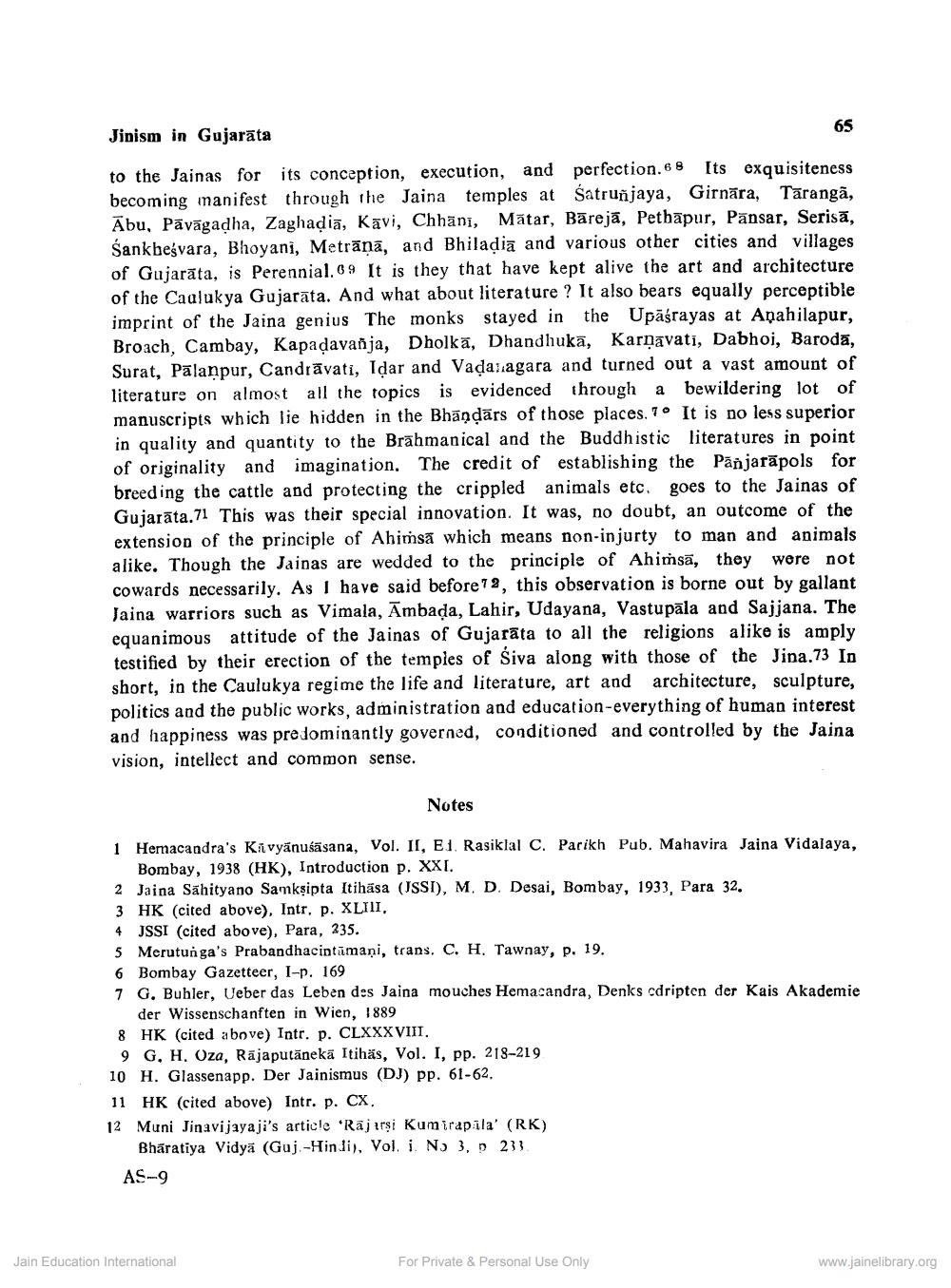________________
Jinism in Gujarāta
to the Jainas for its conception, execution, and perfection.68 Its exquisiteness becoming manifest through the Jaina temples at śatrunjaya, Girnāra, Tarangā, Ābu, Pāvāgadha, Zaghadia, Kāvi, Chhānī, Mātar, Bārejā, Petbāpur, Pānsar, Serisā, Sankbesvara, Bhoyani, Metrānā, and Bhiladia and various other cities and villages of Gujarāta, is Perennial.69 It is they that have kept alive the art and architecture of the Caalukya Gujarāta. And what about literature ? It also bears equally perceptible imprint of the Jaina genius The monks stayed in the Upāśrayas at Apahilapur, Broach, Cambay, Kapadavanja, Dholkā, Dhandhukā, Karnavati, Dabhoi, Baroda, Surat, Pālanpur, Candrāvati, Idar and Vadanagara and turned out a vast amount of literature on almost all the topics is evidenced through a bewildering lot of manuscripts which lie hidden in the Bhāņdārs of those places. 7° It is no less superior in quality and quantity to the Brāhmanical and the Buddhistic literatures in point of originality and imagination. The credit of establishing the Pānjarāpols for breeding the cattle and protecting the crippled animals etc. goes to the Jainas of Gujarāta.71 This was their special innovation. It was, no doubt, an outcome of the extension of the principle of Ahimsa which means non-injurty to man and animals alike. Though the Jainas are wedded to the principle of Ahimsā, they were not cowards necessarily. As I have said before72, this observation is borne out by gallant Jaina warriors such as Vimala, Ambada, Lahir, Udayana, Vastupāla and Sajjana. The equanimous attitude of the Jainas of Gujarāta to all the religions alike is amply testified by their erection of the temples of Siva along with those of the Jina.73 In short, in the Caulukya regime the life and literature, art and architecture, sculpture, politics and the public works, administration and education-everything of human interest and happiness was predominantly governed, conditioned and controlled by the Jaina vision, intellect and common sense.
Notes
1 Hemacandra's Kivyānušāsana, Vol. II, E1. Rasiklal C. Parikh Pub. Mahavira Jaina Vidalaya,
Bombay, 1938 (HK), Introduction p. XXI. 2 Jaina Sahityano Samkşipta Itihasa (ISSI), M. D. Desai, Bombay, 1933, Para 32. 3 HK (cited above), Intr. p. XLIII. 4 JSSI (cited above), Para, 235. 5 Merutunga's Prabandhacintamani, trans, C. H. Tawnay, p. 19. 6 Bombay Gazetteer, I-p. 169 7 G. Buhler, Ueber das Leben des Jaina mouches Hemacandra, Denks cdripten der Kais Akademie
der Wissenschanften in Wien, 1889 8 HK (cited above) Intr. p. CLXXXVIII.
9 G, H, Oza, Rājaputānekā Itihäs, Vol. I, pp. 218-219 10 H. Glassenapp. Der Jainismus (DJ) pp. 61-62. 11 HK (cited above) Intr. p. CX. 12 Muni Jinavijayaji's article Räjarşi Kumirapila' (RK)
Bharatiya Vidyā (Guj.-Hindi), Vol. i. Ny 3, 233. AS-9
Jain Education International
For Private & Personal Use Only
www.jainelibrary.org




